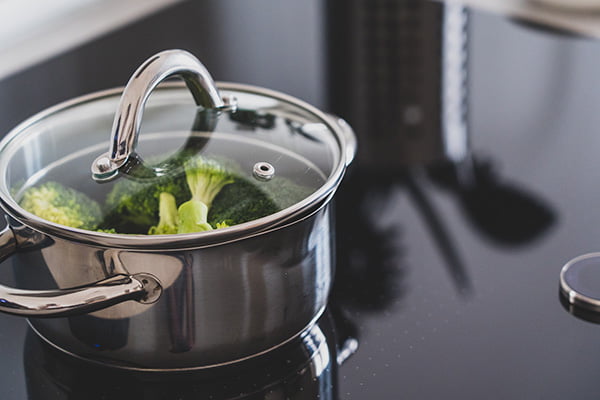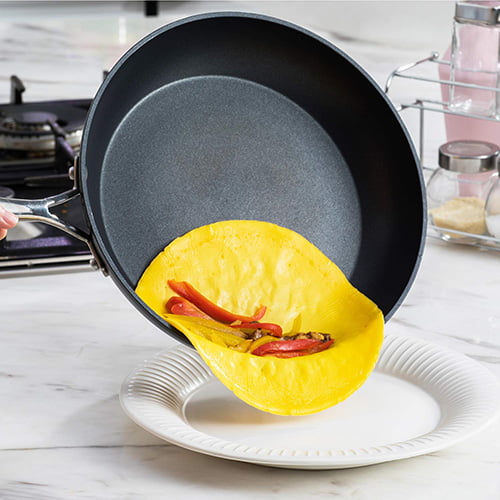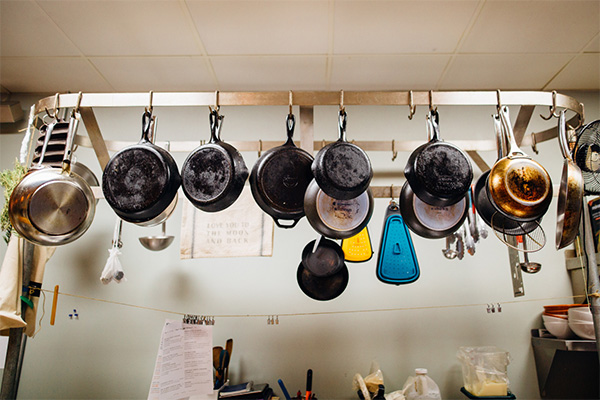In the world of culinary creations, the appropriate cookware holds the power to transform an ordinary meal into a work of art. With so many options available (stainless steel, ceramic, nonstick, carbon steel, cast iron cookware), selecting the perfect cookware can sometimes feel daunting. Among the top contenders in this culinary cage match are the heavyweight champions: stainless steel and nonstick cookware. These two kitchen stalwarts have been duking it out for years, each with its loyal fan base and distinct advantages.
If you've ever been in professional kitchens (or seen them on television shows!), then you've seen the veritable army of stainless steel pots and pans that most professional chefs use. But aren't stainless steel pans a nightmare to clean? On the other hand, using a nonstick pan seems simple, with no tricks to remember or heavy scrubbing afterward. But is it safe to use?
In this comprehensive guide, we'll explore the differences between stainless steel and nonstick cookware, examining their features, benefits, and potential drawbacks.
Benefits Of Stainless Steel Cookware
Durable
Stainless steel pans are incredibly durable pieces of kitchenware! If properly cared for, they will truly last a lifetime. There is no concern about a nonstick coating wearing away over time, and it's perfectly fine to use sharp and metal utensils with them. Stainless cookware is also entirely dishwasher safe.
High Temperatures
Stainless steel cookware can handle high heat - in fact, that's how you're supposed to use them! This means that it's perfect for achieving a deep sear and rich browning on meats. And because there's no nonstick coating to be concerned about, you can deglaze all of the juicy bits after searing and turn them into a delicious sauce.
Oven Safe
You can put your stainless steel pan straight into the oven because it can handle those high temperatures. Make sure to purchase a cookware set that is fully oven-safe, as some might have details on the lids that are not oven-safe. Otherwise, your stainless steel pan can sear a steak and then go straight into a hot oven to finish.
Naturally Nonstick
Stainless steel pans, when used properly, are essentially nonstick! You just have to know how to use them. It's very different from typical nonstick cookware in that the pan must be fully heated up before adding the food. When the pan is properly heated and oiled, however, it's a very nonstick surface!
The Downside To Stainless Steel Cookware

Maintenance
Unlike nonstick pans, stainless steel pans require more maintenance. There is no question of setting the pan in the sink and cleaning it later! Thoroughly cleaning stainless steel demands a significant amount of effort and meticulous attention. However, it actually takes a lot to ruin a stainless steel pan. Even the most discolored or scorched pan can be scrubbed back to a shine.
Cost
Stainless steel pans are a bit of an investment. You'll want to avoid pans and pots with thin bottoms, as they don't distribute heat evenly and can warp. However, middle—to high-quality stainless steel pieces can be well over $100 each, and full stainless steel sets can be multiple thousands of dollars. Remember, though, that these pans are built to endure a lifetime.
Requires Oil, Butter, Or Lard
To cook properly in stainless steel pans, they need to be hot, and there needs to be fat. Using oil, butter, or lard is completely at your discretion and based on your recipe. Cooking with fats does add calories, and some cooks would rather avoid them for various health reasons.
Learning Curve
Mastering the use of a stainless steel cooking surface certainly involves a learning curve. It's very different from using nonstick cookware in cooking and cleaning. The learning process can be frustrating, and you may feel like throwing in the towel while scrubbing at the sink. The payoff is worth it, but it can be a steep climb.
Benefits Of Nonstick Cookware

Simple
It is incredibly simple to cook on nonstick cookware. You can heat the pan beforehand—or not. You can add cooking oil—or not. You can wait until the meat forms a sear before flipping it—or not. You can't really mess up with them! This makes nonstick pans approachable for all levels of home cooks.
Affordable
The affordability of non-stick cookware means that it is an option for every budget. Although there is definitely a range of quality levels within nonstick cookware, as there is with all types of pots and pans, most nonstick pans are affordable for most budgets.
Ease To Clean
Non-stick pans are known for their ease of cleaning due to their slick surface, which prevents food from adhering. Because of its nonstick surface, nonstick frying pans are ideal for cooking delicate food like eggs and fish.
Even after cooking sticky or burnt meals, these pans often require just a quick wipe or a gentle scrub to remove residue. This convenience eliminates the need for harsh scrubbing, using any elbow grease, or soaking, preserving the pan's coating and extending its lifespan while making the cleanup process after cooking remarkably straightforward and time-efficient.
The Downside Of Nonstick Cookware
Wears Down Quickly
That nonstick coating is not long-lasting. Nonstick pans must be stored properly - with a towel or silicone pad between them when stacked - or they will scratch. Metal utensils like whisks will also break down the coating, so you'll be limited to wood or silicone utensils. The coating wears down even quicker if used over its heat limit, which is typically anywhere from 350 to 400 degrees Fahrenheit, or when placed in the dishwasher.
Cannot Withstand High Heat
Due to their coating, nonstick pans are not suitable for high-heat cooking. They must be kept over low or medium heat on the stovetop and never placed in the oven. This limits their cooking potential, as you won't be able to sear meat or achieve a crispy stir fry.
Potential Safety Concerns
In years past, there was significant concern regarding the nonstick ceramic coating flaking off and getting into the food. The Teflon coating substance has been reconfigured since then, but the truth is that most nonstick pans contain Teflon, and, likely, bits of the coating will indeed come off into the food. The EPA and FDA have stated that these small amounts are safe for human consumption, but you must weigh the evidence.
Stainless Steel Vs. Nonstick Cookware: Which One Is The Best For You

Heat Retention
Stainless steel pans tend to have better heat retention and even heat distribution, especially if they have an aluminum or copper core. This makes them suitable for tasks like searing and browning, where maintaining high and even heat is important.
Nonstick cookware generally has lower heat retention compared to stainless steel. It's best for cooking at medium to low temperatures and is ideal for delicate foods that require gentle cooking.
Durability
Stainless steel pans exhibit remarkable durability, enduring high temperatures and rigorous cooking techniques. It's resistant to scratches, dings, and warping, making it a long-lasting option.
Nonstick coatings can be prone to chipping or scratching, impacting their durability over time. They are less resistant to high heat and metal utensils, potentially harming the coating.
Weight
A stainless steel pan tends to be heavier, especially if it has multiple layers or an encapsulated core for better heat distribution.
Nonstick cookware is generally lighter in weight than stainless steel. This can benefit individuals who favor lighter cookware for more convenient handling.
Maintenance
A stainless steel pan requires some attention to prevent sticking, but it's relatively easy to clean if you follow proper techniques. Cleaning stainless steel may involve soaking and gentle scrubbing to remove stuck-on food.
Due to their nonstick coating, nonstick pans require less effort to prevent food from sticking. However, using non-abrasive utensils and gentle cleaning methods is crucial to preserving the coating's integrity.
Ease Of Cleaning
Stainless steel cookware can be relatively easy to clean using proper cooking techniques and avoiding high heat without any liquids. Stuck-on food may require some soaking and gentle scrubbing.
Nonstick cookware is designed for easy cleaning due to its nonstick surface. Food particles are less prone to sticking to the coating, resulting in quicker and easier cleanup.
Lifespan
Due to its durability, stainless steel cookware has a longer lifespan. With proper care, stainless steel pots and pans can remain functional for decades.
Unlike stainless steel pans, nonstick pans typically require replacement around every five years. Nonstick coatings have a limited lifespan, which can be affected by factors like cooking habits, utensils used, and cleaning methods. Over time, the nonstick coating might deteriorate, diminishing its efficiency.
Cost
Stainless steel cookware generally carries a higher initial cost when compared to nonstick pans. This is often due to the quality of materials used, such as multi-ply construction, or the inclusion of other metals like copper or aluminum for better heat distribution. High-quality stainless steel cookware can be considered an investment due to its durability and long lifespan, potentially offsetting the higher initial cost.
Compared to high-quality stainless steel cookware, nonstick cookware is often more affordable. Nevertheless, the expense can fluctuate depending on factors such as brand, composition, and the quality of the nonstick coating. While nonstick cookware may have a lower initial cost, it's important to consider its limited lifespan and the need for potential replacements over time.
Versatility
Both stainless steel and nonstick pans are versatile in the kitchen. The reputation of stainless steel cookware rests on its remarkable versatility. It adeptly accommodates an extensive array of cooking techniques, spanning searing, browning, frying, simmering, and even oven usage. If you frequently sear meats, brown vegetables, or deglaze pans, stainless steel is a better choice. The ability to transition seamlessly from stovetop to oven renders stainless steel especially valuable for recipes demanding a fusion of cooking techniques.
Nonstick cookware is versatile in its own right, but it's best suited for specific types of cooking. If you primarily cook delicate foods like eggs, pancakes, and fish, a nonstick frying pan is more suitable due to its easy food release and gentle cooking surface. Nonetheless, avoiding high-heat cooking, searing, or using metal utensils is advised, as these actions can potentially harm the nonstick coating.
Health Risks
If you're concerned about potential health risks, stainless steel is a safer option, as it doesn't have the risks associated with nonstick coatings at high temperatures. Stainless steel is considered safe for cooking, even at high temperatures. It doesn't release any harmful chemicals or toxins into your food, making it a reliable option for health-conscious cooks.
While convenient, nonstick coatings can pose health concerns when exposed to high temperatures. When heated to very high temperatures, they can release fumes containing perfluorooctanoic acid (PFOA) and other potentially harmful chemicals. It's worth noting that advancements have been made in nonstick technology to produce coatings that are PFOA-free and more resistant to high heat. These options might be safer choices if you opt for nonstick cookware.
Consider Mixing
If your cooking needs vary, consider mixing stainless steel and nonstick cookware in your kitchen. This way, you can use each type for its specific strengths. Choosing a mix of stainless steel and nonstick cookware creates a versatile and adaptable kitchen. This approach lets you choose the best tool for each cooking task, ensuring your culinary creations are consistently excellent. Whether you're searing meat in skillets, sautéing vegetables in frying pans, or simmering sauce in saucepans, having both types of cookware empowers you to elevate your cooking game and enjoy a diverse range of dishes.

